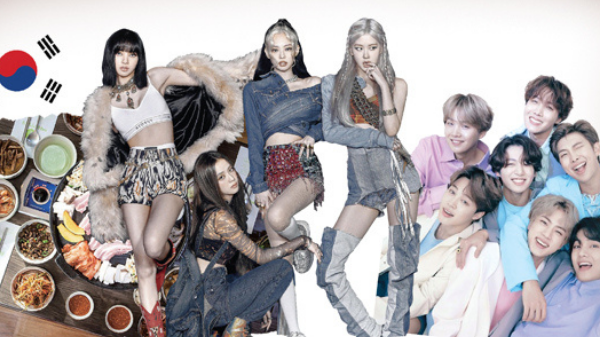
Hallyu to the World: The rise and rise of Korean Culture
Back in 1960, South Korea was one of the world’s poorest countries. In the wake of the Korean War, the northeast Asian nation was so poverty-stricken that its GDP per capita clocked in at a meagre US$79. Fast forward six decades, and the country is on an incredible high. Having transitioned from a largely agricultural economy to a high-tech producer of semiconductors, phones and cars, it boasts the fourth largest economy on the continent (in terms of nominal GDP), lagging behind only China, Japan and India.
Home to such plugged-in conglomerates as Samsung, LG and Hyundai, South Korea has also spawned a whole new hit of global exports: Hallyu. If the term is new to you, chances are the phenomenon it represents is not. For the uninitiated, Hallyu is the romanised form of hanryu, the term for what has come to be known as the Korean Wave – the immense growth and export of the country’s pop culture to the world.

When this movement first began some 20 years ago, it was quickly adopted by neighbours China and Japan, but today Western nations are equally enamoured with all things Korean, be it movies like the 2019 Academy Award-winning film Parasite, TV shows such as 2020’s Crash Landing on You and last year’s record-breaking Squid Game; music (think wildly successful bands such as BTS and girl squads Girls Generation and Blackpink); food, and even cosmetics.
The current global love for all things South Korean can be traced back to the turbulent times of the 1997 Asian financial crisis, when the nation took active measures to restrict cultural imports from Japan. To fill the resulting void, a new mission to foster and strengthen local culture and talent was initiated, including pouring funds into creative industries such as film and TV studios. High-quality Korean dramas were produced very cheaply, and these new media offerings rapidly gathered a fan base in China before reaching further afield. Thus, Hallyu spread to the West, piquing the curiosity and capturing the imagination of the ’90s generation.
Also Read: Most famous Asian royals to follow on Instagram!
K-wave

Many liken the beginning of the Korean Wave to the popularity that Japan itself experienced around that time, when anime, manga, J-pop music and such heavy hitters as Pokemon and Studio Ghibli gained cult status beyond its shores. However, the critical difference between them is that Hallyu managed to capitalise on the emerging trend of digital globalisation, and thus became accessible to a wider international audience.
As Margot Peppers, Consumer Trends Editor at Foresight Factory, explains: “[Japanese culture is] still seen as offbeat, quirky and cool to like, but it is not necessarily mainstream. [Whereas] there has been such a push for K-dramas and stories that are rooted in Korean settings but still have universal themes and archetypes that everyone across the globe can relate to. They are built on this accessible universality that has really resonated with people.”
K-beauty

It’s no secret that standards of beauty are often set by what society sees in the media, and given the widespread dissemination of Hallyu, it’s not surprising that many young people want to mimic the pristine, pale skin of Korean celebrities, paving the way for the rise of K-beauty. The country’s cosmetics industry responded deftly, introducing a constant flow of new, innovative and sometimes unusual ingredients – snail slime, starfish extract, pig collagen and bee venom, to name a few – to serve up the Next Big Thing to consumers.
As a result, the South Korean beauty and cosmetics market now ranks among the top 10 worldwide. According to a study published by Portland-based research company Allied Market Research, the business was valued at US$10.2 billion in 2019 and is projected to grow to US$13.9 billion by 2027 – representing a staggering 36-percent increase.
Also Read: Beauty Airbrushing: Why filters are denting our confidence
K-dramas

South Korean dramas always had an avid fanbase across Asia and its diaspora population, but they have now hit their stride on a global scale. It began when streaming service Netflix decided to break into K-dramas – as the country’s TV series are affectionately dubbed – and debuted its zombie drama series Kingdom in 2019. Since each episode cost a whopping KRW 2.2 billion (about HK$14.4 million) to make, the investment into Hallyu’s popularity was a gamble, to say the least, but the show was received with great acclaim.
Next to break records was Crash Landing on You, which stayed on Netflix Japan’s Top 10 list for 229 consecutive days; it even became the sixth most-watched series in the US. But that all pales in comparison to the enormous cultural impact of nail-biting survival series Squid Game. Having been streamed for a whopping 1.65 billion hours in the first four weeks of airing, it is Netflix’s biggest series launch ever, outstripping nearest competition Bridgerton almost two-fold.

Korean movies were no less in the spotlight, with comedy-thriller Parasite becoming the first non-English-language film to clinch Best Picture at the Academy Awards. Director Bong Joon-ho nabbed the Best Director prize as well. Then, last year, Minari – which follows the travails of a family of South Korean immigrants in rural ’80s USA – also garnered an Oscar (for supporting actress Youn Yuh-jung), prompting a new generation of Western cinephiles to explore other works by the creative talents in these films.
K-pop

While Korean food, cosmetics and films have undoubtedly permeated throughout Asia and the West, there is one aspect of Hallyu that outstrips them all – K-pop. Thanks to its distinctive blend of addictive melodies, slick choreography and production values, and an endless parade of attractive performers who spend years in gruelling studio systems learning to sing and dance in synchronised perfection, K-pop has become a global phenomenon.
No band exemplifies the rise of this sensation than BTS; the country’s leading musical act raked in a massive US$4.65 billion for its economy in 2019. To put that sum into perspective, it equates to 0.3 percent of South Korea’s entire GDP, and more than what many small African nations earned within the same timeframe.
While naysayers may scoff that Hallyu is but a passing phase, the mercenary truth of the matter is that the staying power of the movement is reflected by the financial gains involved. What’s more, it’s not just the bands and the nation that are basking in reflected glory – it’s multinational brands as well, with everyone from McDonald’s and Nike to Louis Vuitton cashing in on collaborations with BTS and their ilk. As long as the attractiveness of the Korean Wave continues to enchant fans, the world will remain at their dancing feet.
Also Read: 10 Most anticipated Asian movies to watch in 2022







